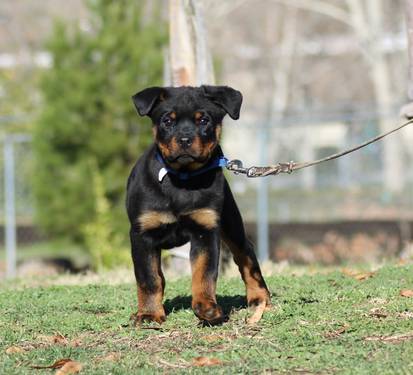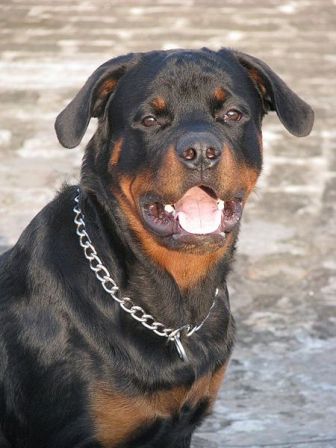Rottweiler Ears
A Rottweiler’s ears should sit level with the top of his head. They should give strength and add width to his overall head piece. They should also be carried close to his head.


“Yurii” Guardian Yazra Von Gottschalk Guardian Isis Von Gottschalk
When a Rottweiler’s ears are either set or carried incorrectly, it distracts from the appearance of a strong, broad head. Sometimes, the ears are set too high- this is genetics and although taping might help them lay closer, they will remain high set for the dog’s life. Sometimes, however, the ears are set correctly, but when the puppy starts teething, the discomfort from the teething process causes the puppy to hold his ears back. The cartilage in a pup’s ears is very malleable and trainable, meaning, if it is held or carried a certain way for a length of time, it will have the propensity to stay that way. So, when a puppy pulls his ears back in response to the discomfort of teething, his ears can sometimes start to fold back and then stay that way. By taping his ears, we retrain that cartilage to fold the correct way so that the pup’s ears are carried correctly.


The pup to the left’s ears are set too high. They fold correctly and are carried as correctly as they can be, so taping would not help this pup significantly.
The Rottweiler to the right has ears that are both set and carried incorrectly. Although taping will not affect how high the ears are set, it will greatly improve how they are carried. When the ears are carried out so far away from the head, they are called “fly away ears”.

The Rottweiler above has ears that are set correctly, but one is carried incorrectly. It likely went off when he was teething and could have been corrected with taping.
Ear taping is simple, non-invasive, and only has to stay on for a couple of days. There are no medical benefits to correctly set ears, so do not feel obligated to tape if you would rather not. I have heard some breeders say that by taping the ears, you help prevent water and debris from getting into the ear and prevent ear infections. Unfortunately, the opposite is true. Drop eared dogs (where the ears fold over) like the Rottweiler get more ear infections than prick-eared breeds (where the ears stand up- like the German Shepherd). This is because as water gets into the ear, the air does not access it freely to dry it out and it can sit in there and potentially cause a yeast or bacterial infection. So, regardless of whether or not you tape, please make sure to keep your dog’s ears cleaned regularly, especially after swimming, bathing or exposure to water in the face/ears.
Here is a short video on correctly taping your Rottie’s ears. There are loads of techniques out there, but this particular method was shown to me by an FCI Rottweiler Judge and I have found it to be quite effective! In most cases, you need only tape one time to correct the ear set, but occasionally, you may need to repeat. The most effective time to tape a Rottweiler’s ears is while the cartilage is still growing (4-10 months usually). I have had some pups that I tape once, and that was all they needed, and others I have taped multiple times. Sometimes after taping, the ears will be carried perfectly, however, since the pup is not done teething, if s/he continues to pull them back, they may require taping again down the road. Although taping is most effective while the cartilage is growing, I have heard some people have success with it even on an older dog. Because it is easy, cheap, and non-invasive, I say you have nothing to lose by trying.




